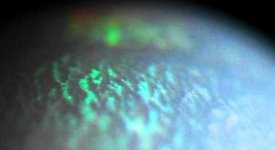Hi Friends,
Delay because I was waiting for authentication. SSEF in Basel, Switzerland, Professor Hanni in command, returned the pearl today and calls it from a marine gastropod, unworked, porcellaneous with flame pattern. Thus it could be a white melo melo, a white conch, a cassis....but not any bivalve such as Tridacna or scallop, nor any cephalopod like a Nautilus. The most costly color of conch is deep pink, and the most costly melo melo an intense orange, but perfect whites such as this and others I have are also quite valuable.
Using electron microscopy, it can be seen that the flame pattern originates in the way the crystalline stuctures alternate from radial to circumferential orientation.
I find it frustrating that the specific gastropod cannot be identified. I plan to try my own DNA testing at Stanford University in the next few months to see if greater specificity can be achieved. This assumes that inside a pearl, in some of that 3-4% water content, a few pieces of DNA or RNA are floating around. Mybe there is not enough genetic material to test.
Whatever we may learn, by this message I hereby call upon the reference laboratories and pearl scientists to cogitate about beginning their own investigation into using DNA typing, in the hope of opening a new world. Imagine if pearls somehow lead to a major medical advance. What if the human body could learn, via DNA fragments, to put a calcium wall around a malignant tumor and simply strangle it to death?
AAA surface, 24 carats, 18mm
Regards to all,
Tom Stern,MD



